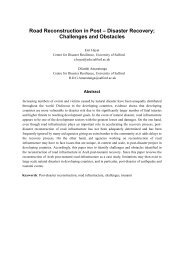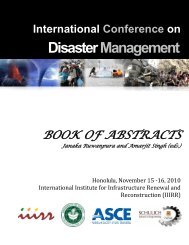Alternative resilient livelihood option for fisher-folks tsunami victims
Alternative resilient livelihood option for fisher-folks tsunami victims
Alternative resilient livelihood option for fisher-folks tsunami victims
You also want an ePaper? Increase the reach of your titles
YUMPU automatically turns print PDFs into web optimized ePapers that Google loves.
1.1 Objective<br />
The main objectives of the study are to assess the growth and production per<strong>for</strong>mance in-situ<br />
floatinf rafts farming of Gracilaria under different conditions and it can also be ascertain whether<br />
the aggregation of herbivorous fish, economic feasibility of mud crab Scylla serrata in wooden<br />
cages and initiated milk fish farming Chanos Chanos in cages as brackish water culture among the<br />
mangrove vegetation at Paalameenmadu through the CIDA Restore project as an alternative<br />
<strong>livelihood</strong> to the <strong>fisher</strong>men <strong>for</strong> proper utilization of available resources in their region, to reduce the<br />
pressure in the coastal marine ecosystem and <strong>for</strong> increasing the opportunity <strong>for</strong> additional income<br />
generation other than fishing.<br />
1.2 Background of the project area<br />
Paalmeenmadu is a small village located about 5 kilometers from the Batticaloa town in East coast<br />
of Sri Lanka. Most of the people of the area are engaged in fishing activities. This is one of the most<br />
environmentally damaged coastal area of the Batticaloa district by both the Tsunami disaster of<br />
December 2004 and the destruction of ecologically sensitive mangrove area due to unplanned<br />
developmental activities following Tsunami. Population increases, lack of other employment<br />
opportunities, and low literacy level <strong>for</strong>ce the local villagers to depend mainly on the <strong>fisher</strong>y<br />
resources that can be harvested from the adjoining lagoon nourished with mangrove biota. As most<br />
of the <strong>fisher</strong>men do not have adequate financial support <strong>for</strong> in board engine boats and deep sea<br />
going vessels, they are restricted to coastal areas and the bar mouth area of the lagoon that are easily<br />
accessible with small lagoon canoes. Strained by decreasing fish catches, they are often compelled<br />
to use more effective and also destructive fishing methods, which reduce the productivity of the<br />
coastal resources even further. Over fishing and the use of destructive fishing methods have been<br />
prevalent <strong>for</strong> many years in this village.<br />
2. Materials and Methods<br />
The CIDA Restore project’s implementation sites were Puthukudyiruppu and Paalameenmadu. We<br />
did Participatory Rural Appraisal (PRA) and water quality survey to select the most suitable site <strong>for</strong><br />
farming. According to our survey Paalameenmadu was found to be the most suitable place to<br />
implement the project. The inmates around this area were given an awareness program on seaweed<br />
farming crab fattening and milk fish farming. We selected the most interested and poorest village<br />
<strong>folks</strong> <strong>for</strong> farming. Though the maintenance works were carried out by the public the readings were<br />
taken down by us. The study was carried out from July 2008 to May 2009. The growth rate was<br />
monitored each week and the mean time water quality parameters including salinity, temperature,<br />
pH, rainfall, water flow rate, turbidity and dissolved oxygen were measured using calibrated Hanna<br />
portable instruments

















